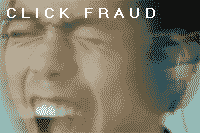Breaking Through Click Fraud Hype

Definitions, Suggestions and Solutions for PPC Advertisers
| Is click-fraud rampant on the Web? It's hard to tell these days. On one side, PPC advertisers and Internet journalists have taken notice and addressed a seemingly serious problem. On the other side, fear mongers from the halls of CPM oriented Interactive media havens and click fraud prevention services or software providers are putting a negative spin on an online advertising issue which is (let's be honest) easy to target. |
|
In order to break through the hype it is first important to understand what actually constitutes click fraud. Since there are many different levels and types of this ad manipulation it is vital to establish a definition before suggesting a solution - which is ultimately our aim in this article.
| Instant Survey: |
Types of Click Fraud
There are essentially three types of click-fraud: automated, insincere and malicious. Since the different types of click fraud all have the same effect (depleted advertising funds) PPC advertisers must stay competitive in the online advertising landscape by realizing the importance of the differences. The reason is that your approach to curing the ills of click fraud will be different for each pay per click search engine.
Automated Click Fraud: This form of PPC fraud is usually the one that elicits the most feverish response. The thought of an automated software program racking up clicks on search return lists and draining an advertiser's budget while advertisers are helpless to do anything is a frightening scenario. Fortunately, automated programs are usually the easiest to notice for fraud prevention departments of the ad network.
If you think you've been the victim of automated click fraud, contact the fraud detection team at the PPC engine providing the ad-driven traffic. Notify the network that you believe there to be a pattern of poor quality traffic in a set period of time. This is usually enough information for the PPC to analyze the traffic, review your server logs and identify the IP address or block of IP addresses that you suspect are behind the click fraud or poor quality traffic. If you think you have been the victim of automated click fraud, always ask for a refund for clicks generated in the suspect period of time.
Insincere Click Fraud: One of the most preventable types of fraudulent ad traffic is that from insincere clicks - specifically from search engines who provide their members incentives to click through and visit the site in exchange for credits, commission or percentages of an advertisers bid price. Incentive programs wreak havoc on the ROI of advertisers since the only intention of users visiting their site is to profit without a genuine interest (hence the term insincere) in the products or services being offered by the advertiser.
If you think you have been the victim of insincere click fraud, you (the advertiser) are the only one to blame. The reason is that you should know beforehand how the network sends you traffic (organic, contextual, search boxes, etc.). PPC advertising in many respects is "partner-centric" in that the networks rely on the efforts of others to send traffic to the PPCs advertisers. Partners that lure clicks from their members through incentives are considered by most to be poor in quality. The easiest way to avoid insincere clicks is to avoid PPC networks that use incentive programs as partners. Before setting up an account, always ask the sales department of the PPC this question and you will dramatically reduce the chances that you will be a victim of click fraud.
Malicious Click Fraud: There are two types of malicious click fraud. The first is caused by a malicious competitor routinely clicking on listings in an attempt to deplete the advertising account funds. The sole intent is to remove the advertiser from the return list, in effect moving them (the fraudster) up the return list to a higher position. The other type of malicious click fraud has been dubbed impression fraud. Since one PPC in particular bases your bid price partly on the click-through rate of your ad (charging an increased rate the more your ad is seen), the more impressions you have will in some roundabout way deplete your funds.
If you think you have been the victim of malicious click fraud - be proactive. It is essential that you frequently analyze your server log files when you notice anomalies in your standard traffic pattern. Again, repeated clicks from the same IP address should usually be considered a malicious click pattern and should be reported to fraud teams at the PPC in question. Come to the table with your own evidence and the chances that you will be refunded are improved greatly.
How Pay Per Click Networks Identify Fraud
Pay per click search engines typically use their own proprietary technology to analyze and determine whether clicks fit a fraudulent pattern. Most systems are able to identify bogus clicks using and applying the following means:
- Detection and filtering techniques: The majority of PPC's analyze all clicks through detection programs and established filtering systems. These programs and systems monitor clicks from IP addresses, the time of each click, duplicate clicks, and overall click patterns. Triggers are set to isolate and filter out any fraudulent clicks and in some cases warn abusers by blocking them entirely.
- Advanced monitoring techniques: In order to stay ahead of changing ad trends and their corresponding invalid click techniques some PPCs have applied for patents to protect the software that identifies fraudulent activity on advertiser listings. Pay per click networks do not release this information because, essentially, once the secret is known security is easily jeopardized.
- Human expertise: In addition to an automated click protection system, pay per click networks should have a team dedicated to examining individual instances of invalid clicks. When questions arise, these experts (trained in identifying fraudulent click activity) should examine affected accounts and shut off source of the invalid clicks. The pay per click advertising network you choose should have a human component of click fraud and you should speak with them if you are concerned about fraudulent click activity in your account.
What can you do about click fraud?
There are some basic things you must know and do to protect yourself from being a continual victim of click fraud. The first and most important thing you should do is to not hesitate when you suspect your listings have been clicked fraudulently. Since most PPC's have departments that focus on click-fraud, they are essentially waiting for you to lead them to the traffic.
Know Your Data
Do not just say "I'm a victim" - come armed with proof. There is nothing more discouraging from the vantage point of a PPC to have an advertiser claim that bad traffic is occurring without the hard data to prove it. So what kind of hard data should you provide your PPC? As we mentioned in this article, analyze your raw server log files and seek out the date and time of the suspect traffic and the IP addresses you suspect as the culprit. This will give click fraud departments a head start in cutting off low quality traffic sources.
Measure Your ROI
The single greatest defense against click-fraud is measuring your return on investment. Over time, by learning which promotional sources send your website traffic that actually converts, you will be able to focus your PPC advertising campaigns on networks which produce the greatest ROI for your bottom line.
While there is no denying that click fraud exists on pay per click advertising networks of sizes, an informed Internet community is the first step in securing precious advertising and marketing investments.










